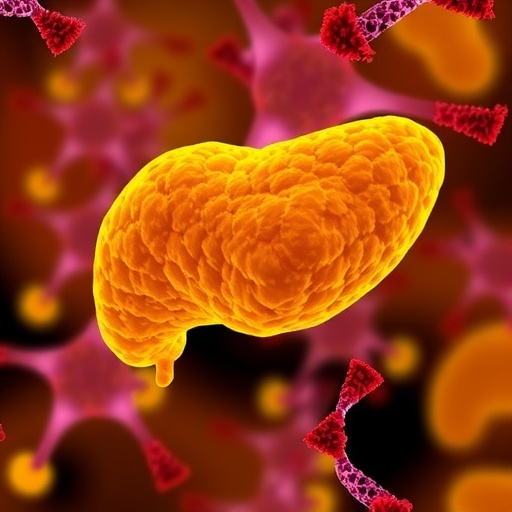
Credit: Image courtesy of Stephen Back, M.D., Ph.D., Oregon Health & Science University.
A new study identifies a molecule that may be critical to the repair of white matter, the fatty tissue wrapped around parts of brain cells that helps speed up communication. Damage to white matter is associated with several conditions, including multiple sclerosis and cerebral palsy, and can occur in the brains of preterm babies. New findings suggest that the molecule triggers a pathway that is normally used by the immune system to prevent excessive damage but may contribute to chronic white matter injury by completely blocking repair operations. The study, published in the May issue of Journal of Clinical Investigation, was funded by the National Institute of Neurological Disorders and Stroke (NINDS), part of the National Institutes of Health.
"This study uncovers a new player in white matter disease and identifies a potential drug target," said Jim Koenig, Ph.D., program director at NINDS. "It also describes a unique situation in which the brain tries to take over immune system functions, with devastating results."
White matter, also known as myelin, is formed by oligodendrocytes, specialized cells that come from developing cells called oligodendrocyte progenitor cells (OPCs). Studies have shown that in cases of chronic white matter injury, OPCs accumulate in the lesions, ready to help, but for some reason are not able to produce myelin. A very large molecule called hyaluronic acid (HA) also accumulates in the lesions and is broken down into small fragments that are thought to prevent OPCs from producing myelin.
A team led by Stephen Back, M.D., Ph.D., professor of pediatrics and neurology at the Oregon Health & Science University in Portland, took a detailed look at the HA fragments to see how they block myelin repair. Using state-of-the-art techniques, Dr. Back and his colleagues were able to create HA fragments of different sizes.
Results showed that only one specific size of HA, the 210 kDa fragment, had an effect on OPC proliferation.
Dr. Back and his team treated rat cells that mimicked white matter disease with the 210 kDa HA fragment. They discovered that the HA initially turned on molecules associated with myelination but then shut them down completely, a strategy that is similar to immune tolerance, which is used by the immune system to prevent severe tissue injury from an ongoing, damaging response to bacteria and viruses.
"We showed that HA creates not just a roadblock to myelin repair after injury, it also shuts down all of the possible detours," said Dr. Back. "Tolerance can be helpful in preventing the brain from repairing itself too quickly, but in some disease conditions, it can turn into a detrimental response."
Dr. Back and his team also discovered that the 210 kDa fragment signals to TLR4, a protein that oversees immune tolerance, to activate FoxO3, which helps control the activity of genes involved in myelin repair. This activation of FoxO3 eventually leads to a decrease in the activity of myelin-related genes and a slowdown in white matter repair. However, this process only takes place if HA is present.
When Dr. Back and his group looked at human brain tissue affected by white matter injury and multiple sclerosis, they found activated FoxO3 in OPCs that were blocked from producing myelin.
In the brain, the large, intact HA makes up most of the extracellular matrix, the substance found between cells. Damage to the extracellular matrix leads to inflammation and this can occur in white matter injury.
"For decades HA was thought of as simply a glue holding everything together. In recent years, we have come to learn how critical this molecule is for various pathways and potentially, many neurological disorders," said Dr. Back.
More research is needed to learn about the molecules involved in white matter repair as well as the role of different HA fragments in these processes.
###
The study was funded by NINDS (NS054044, NS045737), the National Institute on Aging (AG31892), American Stroke Association, Congressionally Directed Medical Research Programs (MS160144) and the National Multiple Sclerosis Society.
For more information:
http://www.ninds.nih.gov
https://www.ninds.nih.gov/Disorders/All-Disorders/Multiple-Sclerosis-Information-Page
Reference:
Srivastava T et al. A TLR/AKT/FoxO3 immune-tolerance like pathway disrupts the repair capacity of oligodendrocyte progenitors. Journal of Clinical Investigation. 2018 May 1;128(5):2025-2041. doi: 10.1172/JCI94158.
###
The NINDS is the nation's leading funder of research on the brain and nervous system. The mission of NINDS is to seek fundamental knowledge about the brain and nervous system and to use that knowledge to reduce the burden of neurological disease.
About the National Institutes of Health (NIH): NIH, the nation's medical research agency, includes 27 Institutes and Centers and is a component of the U.S. Department of Health and Human Services. NIH is the primary federal agency conducting and supporting basic, clinical, and translational medical research, and is investigating the causes, treatments, and cures for both common and rare diseases. For more information about NIH and its programs, visit http://www.nih.gov.
Media Contact
Barbara McMakin
[email protected]
@NINDSnews
http://www.ninds.nih.gov




